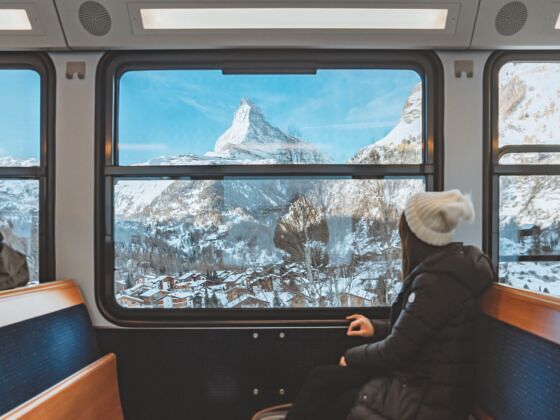Traveling by train often evokes a certain sense of nostalgia, even if train travel wasn’t exactly a staple of your childhood. Like hailing an ice cream truck or watching Leave it to Beaver reruns, there’s something about riding the rails that simply feels old school. Maybe it’s because trains predated cars, and were once the most ubiquitous and convenient way to travel. Or maybe it’s because in many parts of the world — particularly the US — trains haven’t been updated since Leave it to Beaver was airing new episodes. While the old-timey feeling can certainly be fond, we don’t want our trains to feel outdated. Luckily, thanks to plenty of rising trends and new innovations in train travel, trains are becoming less antiquated and more appealing — even cool. We talked to several experts to learn where the train industry is at right now, and where we can expect it to go.


Experts Predict the Future of Train Travel and It’s Looking as Bright as Ever
The future is faster
It’s no surprise that when it comes to train travel — and any form of transportation — the future means faster. High-speed trains are already prevalent throughout the world, but are poised to explode in ubiquity in the coming years.
“In Europe, they are already well ahead in terms of accessibility and efficiency,” says Dave Conway, founder of EcoMotionCentral, a sustainable transportation organization, “but the US is catching up quickly. The future of EU train travel will likely be different than US train travel, however, since the EU has invested more in high-speed rail infrastructure and has more experience with this type of travel.”
But it’s not just Europe that’s throwing its hat in the high-speed ring.
“Japan has long led the pack in high-speed rail, and I reckon it will continue to do so (I have fond memories of zipping across Japan aboard the Shinkansen, or the famed ‘Bullet Train’),” says Anne Sutherland, destination expert for Japan, South Korea, and Australia. “But it’s not just about Japan anymore. Think expanding high-speed rail networks worldwide, even in emerging economies. Take the US, for instance. It’s starting to catch the high-speed rail bug with projects like the Vegas hyperspeed rails.”
Indeed, though it’s still behind much of the world, the US has made strides toward developing a high-speed rail system. In addition to the planned Vegas-LA hyperspeed rails, another railway is set to connect Vegas and Southern California. Brightline West, an extension of Florida’s privately-owned Brightline intercity express rail, is slated to open for operation by 2027.
“Brightline West will be America’s first true high-speed rail system,” according to a representative for Brightline, “with planned speeds up to 200 mph, to connect Las Vegas and Southern California.”
The passenger experience
No matter the industry, with new technologies and innovations often comes an effort to improve the user experience. In train travel, this means improving WiFi, passenger comfort, accessibility, and general convenience.
“Projecting the passenger experience a decade down the line, I see a harmony of efficiency, comfort, and connectivity,” Sutherland says. “Envision relaxing in roomy seats, using high-speed WiFi, and watching the world zip by through panoramic windows, all at breathtaking speeds.”
With more and more people working remotely, WiFi has become increasingly important during transit. Understanding this, Brightline is taking their WiFi to the next level. According to Brightline, the railway is “the first passenger rail service in the world to offer Starlink’s high-speed, low-latency broadband service.”
Apart from on-board technological upgrades, railways are also making it easier for passengers to book, and to conveniently access their trains. Eurail, for example, is investing in mobile tech.
“Eurail continues to keep technology at the forefront of their Pass developments,” says Jody Bauer, Research Analyst for Eurail, a rail pass allowing train travel through 33 European countries, “with nearly all of Eurail’s passes now accessible via mobile app.”
Similarly, Brightline launched Brightline+ in 2021. The fully integrated, door-to-door booking service enables customers to pre-book seamless transportation from their point of origin to their final destination across multiple modes of private and public transportation. Making it as convenient as possible for passengers not only makes everything easier, it’s also an important step toward modernizing train travel and making it more appealing in the eyes of younger travelers.
Trains are going green
Unfortunately, transportation has been one of the largest sectors negatively impacting the environment. Whether it’s air travel, cruise ships, or trains, none of it is traditionally very green. As both consumers and businesses increasingly prioritize sustainability, it’s only natural that trains would start going green.
Indeed, “don’t get carried away by speed alone,” Sutherland says of the future of train travel. “There’s a growing focus on sustainability with innovations such as electric and hydrogen-powered trains.”
Bauer agrees, believing “the future of high-speed train travel abroad will cater to the increased interest from consumers looking for more environmentally-friendly options. US travelers also have an increased interest in commuting by rail on their next European adventure and saying goodbye to short-haul flights.”
The preference for trains over planes has become a popular way to enjoy a more scenic journey, as well as make a more positive impact on the environment.”
Brightline is also putting sustainability at the heart of their ethos going forward, making eco-friendly features a central part of their new high-speed rail network.
“Brightline West will introduce a fully electric, emission-free system,” Brightline says, “making it one of the greenest forms of transportation in the US, removing 3 million cars and 400,000 tons of CO2 each year.”